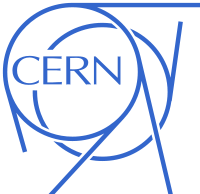CERN - European Organization for Nuclear Research logo.
Dec. 5, 2021
The collaboration reports a value for the Higgs boson’s lifetime that has a small enough uncertainty to confirm that the particle has a tiny lifetime.
Image above: A Higgs boson candidate transforming into four muons (red lines). (Image: CERN).
The Higgs boson doesn’t stick around for long. Once it is created in particle collisions, the famed particle lives for a mere less than a trillionth of a billionth of a second or, more precisely, 1.6 x 10-22 seconds. According to theory, that is, for so far experiments have only been able to set bounds on the value of the particle’s lifetime or to determine this property with a large uncertainty. Until now. In a new study, the CMS collaboration reports a value for the particle’s lifetime that has a small enough uncertainty to confirm that the Higgs boson does have such a short lifetime.
Measuring the Higgs boson’s lifetime is high on the wish list of particle physicists, because an experimental value of the lifetime would allow them not only to better understand the nature of the particle but also to find out whether or not the value matches the value predicted by the Standard Model of particle physics. A deviation from the prediction could point to new particles or forces not predicted by the Model, including new particles into which the Higgs boson would decay.
But it isn’t easy to measure the Higgs boson’s lifetime. For one, the predicted lifetime is too short to be measured directly. A possible solution entails measuring a related property called the mass width, which is inversely proportional to the lifetime and represents the small range of possible masses around the particle’s nominal mass of 125 GeV. But this isn’t easy either, as the predicted mass width of the Higgs boson is too small to be easily measured by experiments.
Quantum physics to the rescue. In addition to being produced with a mass equal or close to its nominal value, a short-lived particle such as the Higgs boson can also be produced with a much larger mass than the nominal value, although the odds of this happening are lower. This effect – and in fact the mass width of the particle as well – is a manifestation of a quantum quirk known as Heisenberg’s uncertainty principle, and a comparison between the production rate of these large-mass, or “off-shell”, Higgs bosons with that of the nominal or close to nominal, or “on-shell”, Higgs bosons can be used to extract the Higgs boson’s mass width and therefore its lifetime.
Large Hadron Collider (LHC)
This is the method employed by the CMS team in their new study. By analysing data collected by the CMS experiment during the second run of the Large Hadron Collider (LHC), specifically data on Higgs bosons transforming into two Z bosons, which themselves transform into four charged leptons or two charged leptons plus two neutrinos, the CMS researchers have obtained the first-ever evidence for the production of off-shell Higgs bosons. From this result, which has only a 1 in 1000 chance of being a statistical fluke, the CMS team obtained a Higgs boson’s lifetime of 2.1 x 10-22 seconds, with an upper/lower uncertainty of (+2.3/-0.9) x 10-22 seconds. This value, the most precise yet, aligns well with the Standard Model prediction and confirms that the particle does indeed have a tiny lifespan.
“Our result demonstrates that off-shell Higgs-boson production offers an excellent way to measure the Higgs boson’s lifetime,” says CMS physicist Pascal Vanlaer. “And it sets a milestone in the study of the properties of this unique particle. The precision of the measurement is expected to improve in the coming years with data from the next LHC runs and new analysis ideas.”
Read more on the CMS website: https://cms.cern/news/life-higgs-boson
Note:
CERN, the European Organization for Nuclear Research, is one of the world’s largest and most respected centres for scientific research. Its business is fundamental physics, finding out what the Universe is made of and how it works. At CERN, the world’s largest and most complex scientific instruments are used to study the basic constituents of matter — the fundamental particles. By studying what happens when these particles collide, physicists learn about the laws of Nature.
The instruments used at CERN are particle accelerators and detectors. Accelerators boost beams of particles to high energies before they are made to collide with each other or with stationary targets. Detectors observe and record the results of these collisions.
Founded in 1954, the CERN Laboratory sits astride the Franco–Swiss border near Geneva. It was one of Europe’s first joint ventures and now has 23 Member States.
Related links:
CMS collaboration reports: https://cms.cern/news/life-higgs-boson
Higgs boson: https://home.cern/science/physics/higgs-boson
Z bosons: https://home.cern/science/physics/z-boson
Standard Model: https://home.cern/science/physics/standard-model
CMS: https://home.cern/science/experiments/cms
Large Hadron Collider (LHC): https://home.cern/science/accelerators/large-hadron-collider
For more information about European Organization for Nuclear Research (CERN), Visit: https://home.cern/
Image (mentioned), Animation (CERN), Text, Credits: CERN/By Ana Lopes.
Greetings, Orbiter.ch



